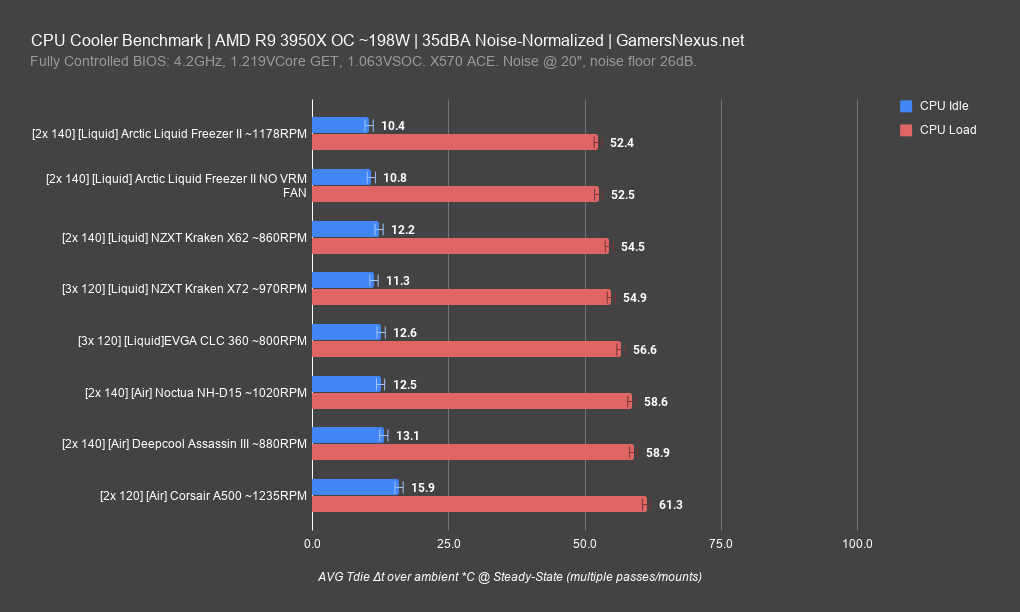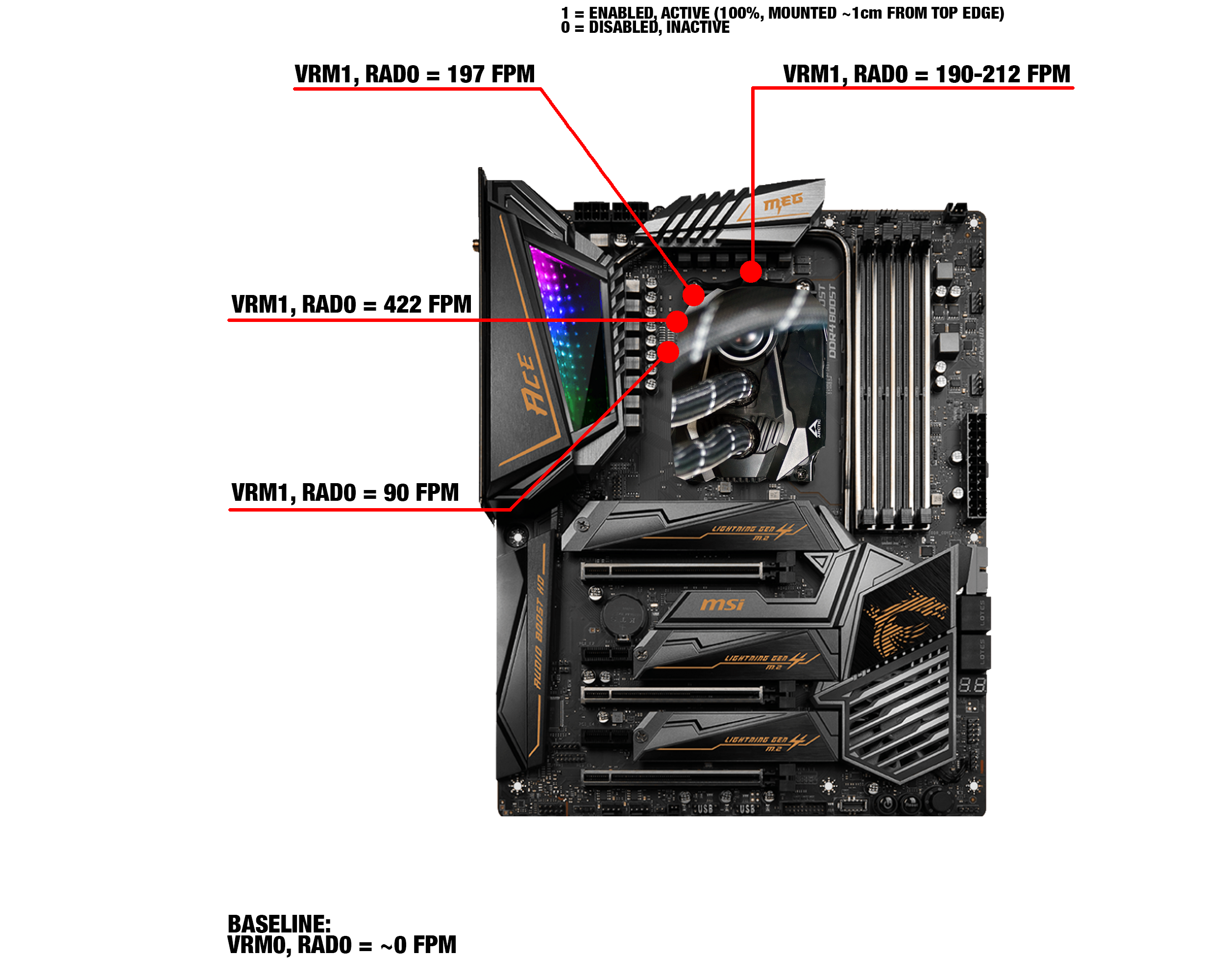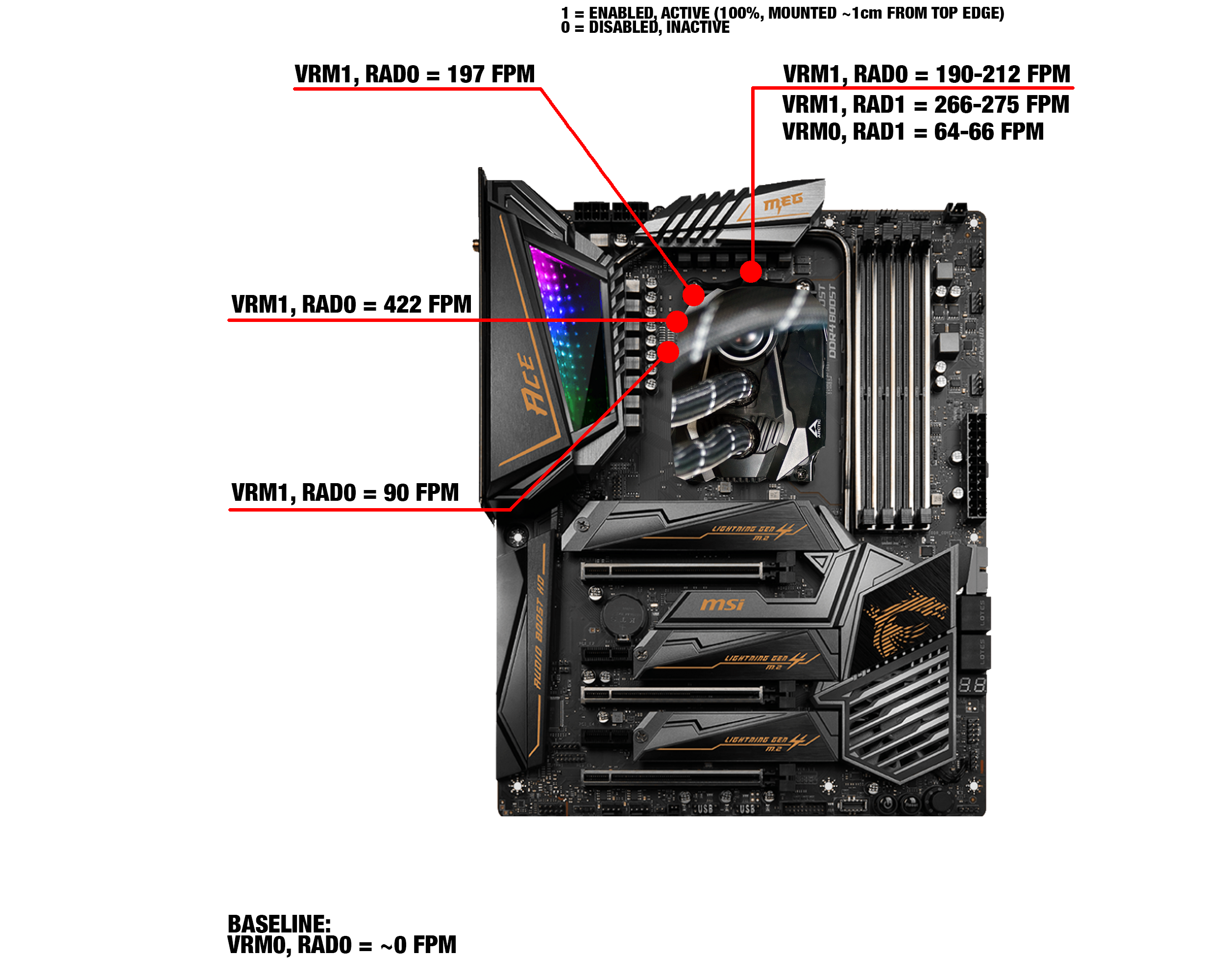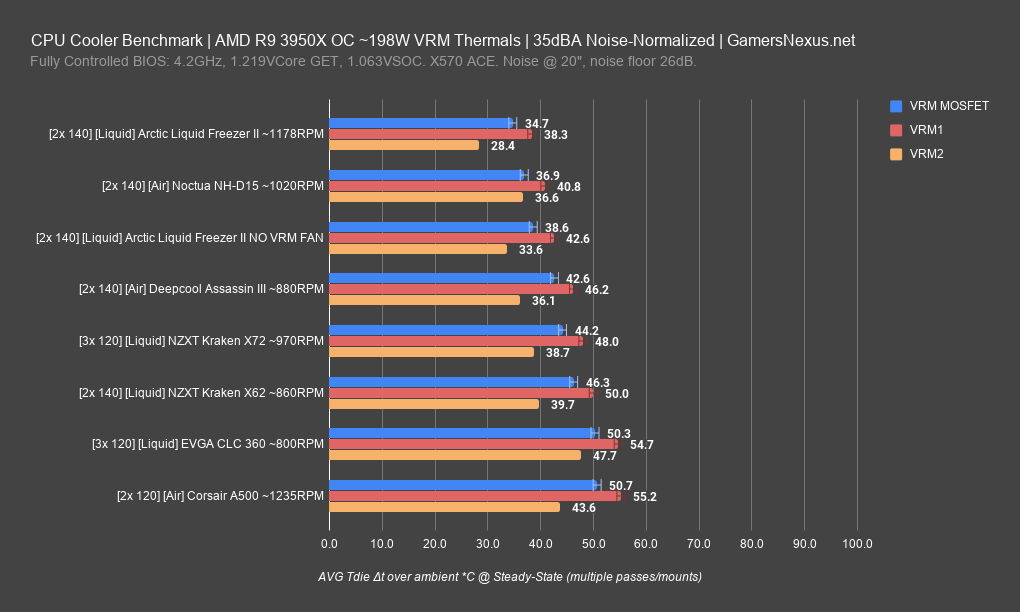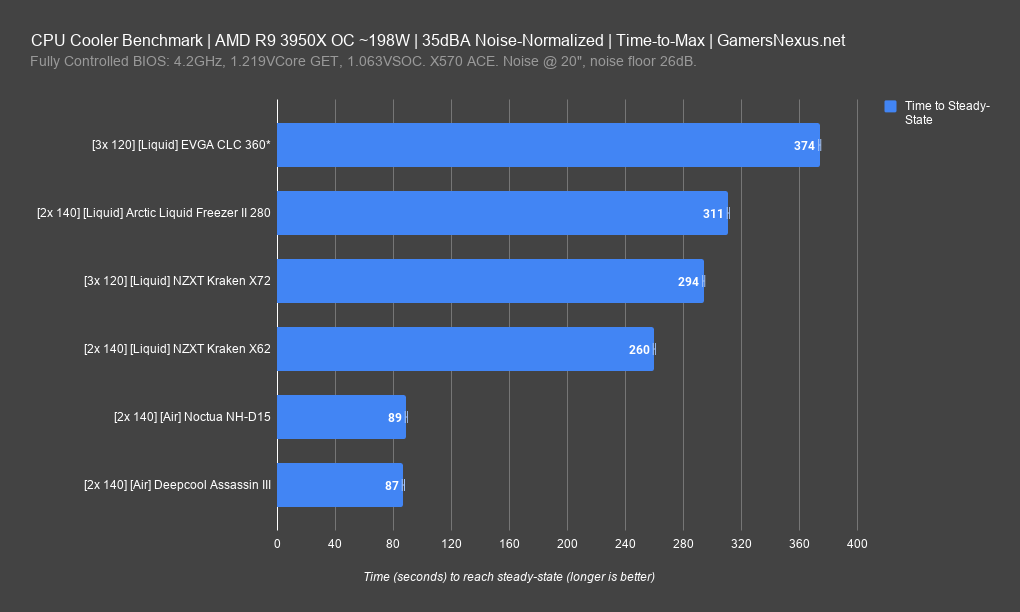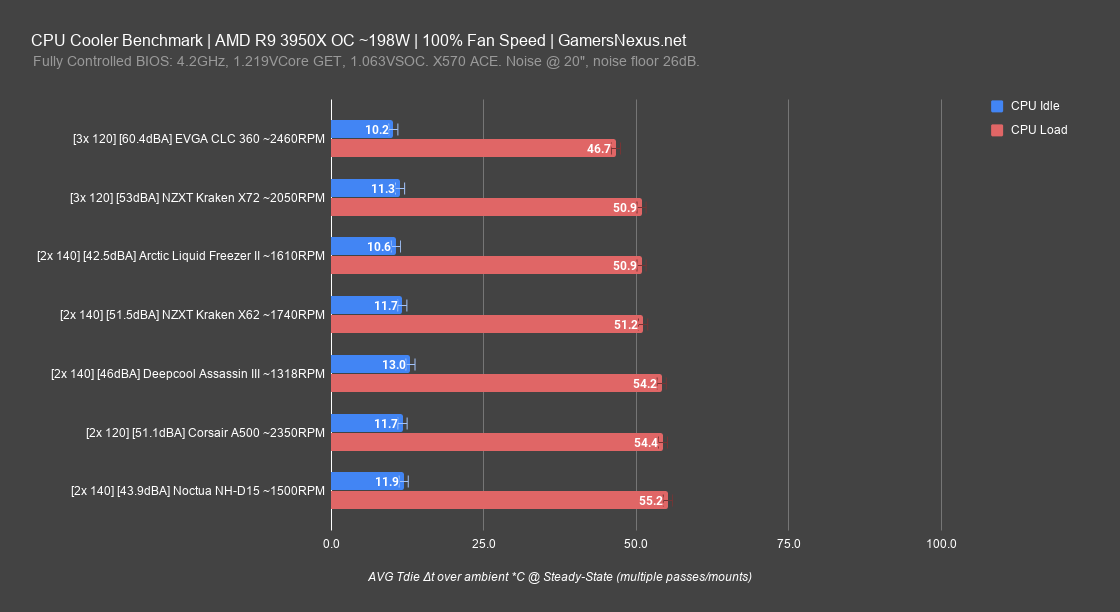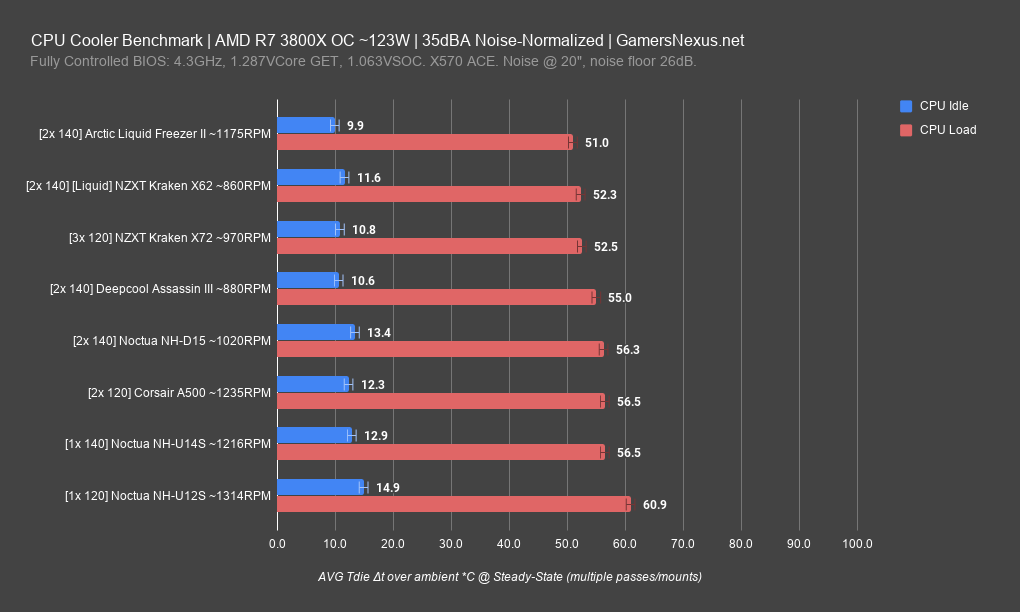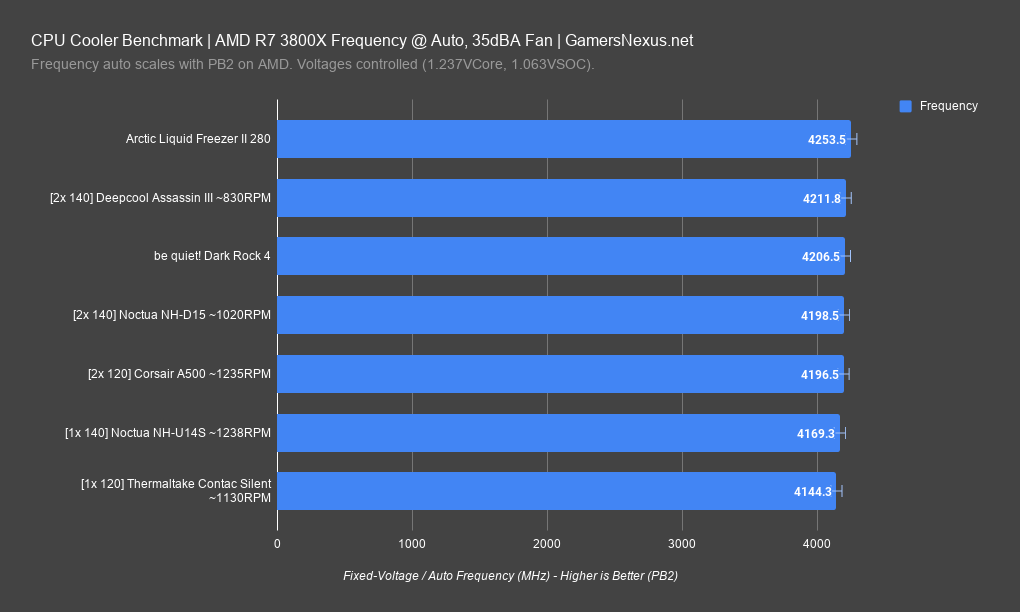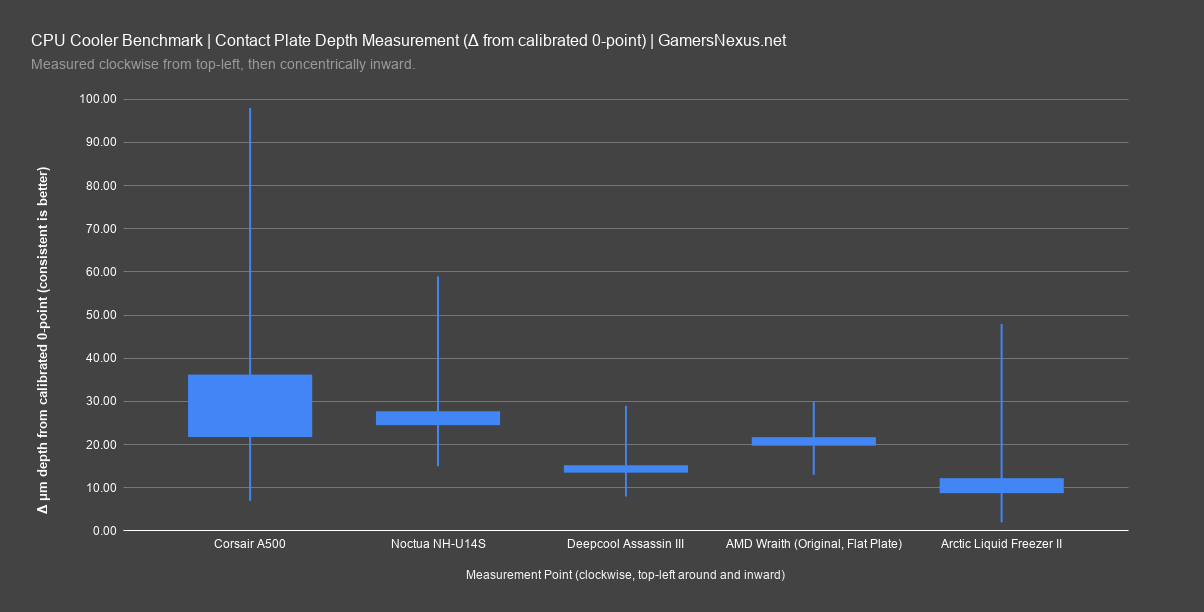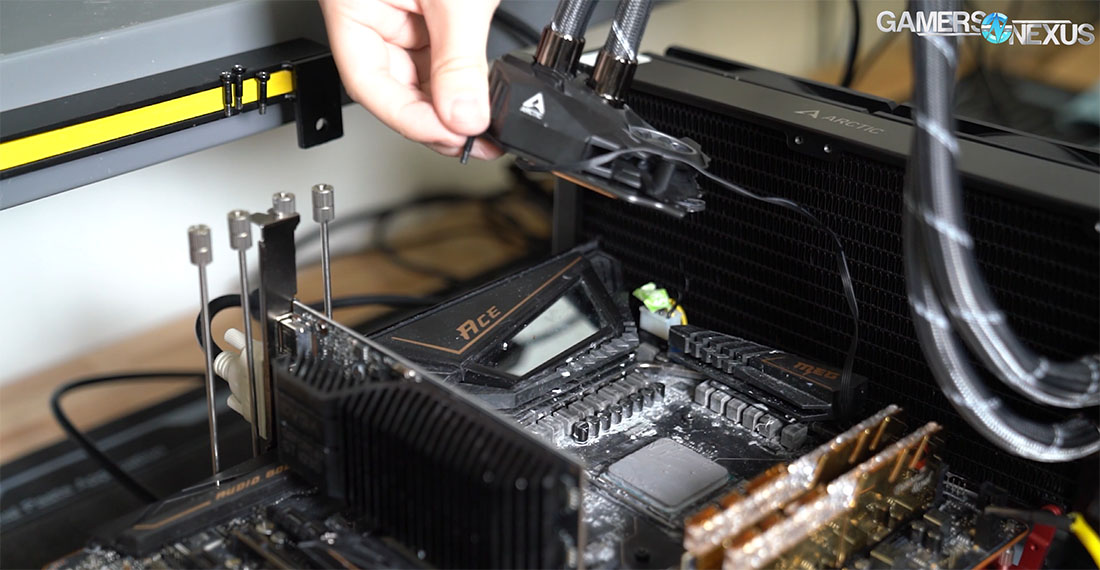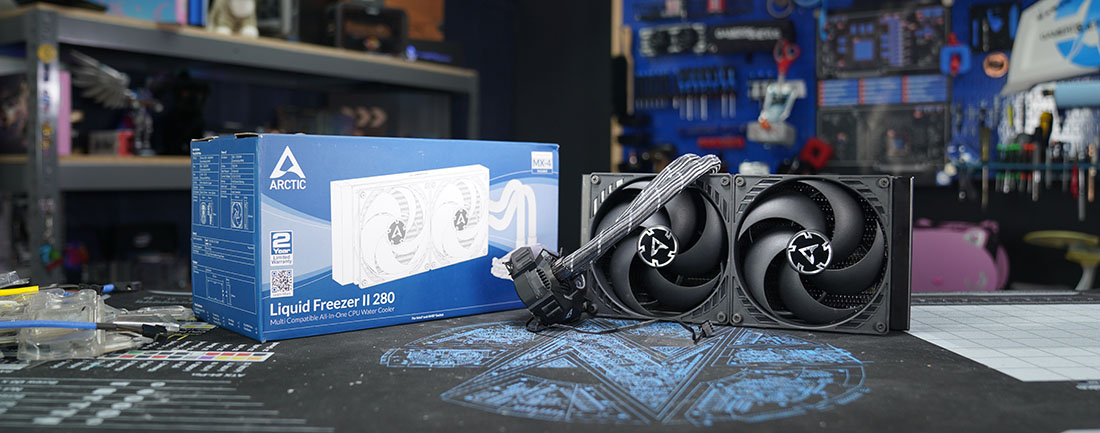Arctic Liquid Freezer II Cooler Review: New Best-Performer for CPU & VRM Thermals
Posted on
Today’s review has been the most-requested review from our commenters for about 6 months now, and it’s not even a piece of silicon. The Arctic Liquid Freezer II series has gotten heavy community interest because of high reported performance in the enthusiast forum userbase. We wanted to look at it with our new testing methodology that we’ve spent six months revising to see how the Liquid Freezer performs against incumbents, including the NZXT Kraken X62 (similar to the X63 we reviewed), the Noctua NH-D15, and a growing list of others. The Liquid Freezer’s biggest marketing point, currently wedged in between being a gimmick and a useful feature, is its included VRM fan on the coldplate housing. Our review includes benchmarks of VRM thermal performance with and without this fan, tested in A/B fashion, and also tests of surface levelness, CPU core thermals on the 3950X and 3800X at 120W and 200W, noise tests, and time-to-max temperature.
Arctic cooling’s Liquid Freezer II came right in time for Zen 2 system builds toward end of 2019, but that was when we were in the middle of upgrading our testing methods. If you’d like to read how we do this testing, you can click this link. We also have a video version available. We won’t be reproducing the methodological information on this page as it’d be redundant.
The Arctic Liquid Freezer II 280 is what we’re reviewing, although variants at 120, 240, and 360 are also prominently featured online. As a quick advisory, we almost unilaterally reject 120mm closed-loop liquid coolers on the basis of horrible performance to price. They mostly exist for system integrators or for special SFF PCs that don’t have the physical space for a tower of any kind. As for the rest, the 240, 280, and 360 series are worth consideration. The 280 Arctic CLC is priced at around $95 at time of writing, which makes it one of the best-priced options on the market (if performance is good, and read on for that). The closest competitors in price would be the EVGA CLC 280, made by Asetek, or maybe some of Cooler Master’s units, made by Cooler Master. Arctic claims to have designed its own pump solution and says that it has used a partner to manufacture it, but we’ll learn more about that when we do our video tear-down in the next few days. Most liquid coolers actually come from only a few companies: Asetek (the largest), CoolIT (growing in the consumer space), Apaltek, Dynatron, and any number of other smaller suppliers. There’s not much diversity overall, and that often means there’s not much change in performance from one competitor to the next. It primarily comes down to fans, LEDs, warranties, and things like that.
Arctic has differentiated itself as much as it could, including the inclusion of a small 40mm VRM fan atop the pump. That feature, as we’ll discuss later, is sort of a gimmick but also not, in that it does work (it’s just not realistically all that useful in most use cases). In instances where you’d really need that VRM fan, you probably should just use a better case, motherboard, or add more fans to the back of the case. Either way, it does work, and that’s something we’ll illustrate today.
3950X – 35dBA
Our next chart will be of the VRM fan performance, but we’ll start with the one everyone is used to. For this one, we’re using a 200W workload with the AMD R9 3950X, which is more useful for stressing the differences in high-end coolers. This test is equalized to 35dBA in order to level the playing field so that coolers can’t just brute-force their way to the top, like the EVGA CLC 360 would do at its 60dBA. Note that we do not change the fans – we use the coolers stock, just set to the same noise level.
The Liquid Freezer II ends up as the top-performer on the bench when noise-normalized to 35dBA across the board. The Arctic Liquid Freezer results were benched 6 times each, with and without the VRM fan, and with 2 sets of re-mounts. The deviation run-to-run was under 1-degree, so consistency was good. The 52-degree load result has the Liquid Freezer II about 2 degrees cooler than the X62 at the same noise level. It’s outdoing the X72 and CLC 360, which both struggle at these lower noise levels because they have too many fans at too small of a size, and so they lose pressure. The NH-D15 is outdone by about 6 degrees Celsius, which is enough to allow some additional overclocking headroom.
At the $95 price, Arctic is kicking everyone’s ass. The NZXT Kraken X62 isn’t anywhere close in pricing, and although the newer X63 is $10 cheaper at $150, its performance isn’t much different. The Corsair A500 gets buried even deeper than it was at launch. The NH-D15 or Assassin III still have uses, mostly related to those discussed in the air vs. liquid content, but other CLCs will mostly come down to LEDs or warranties. The Liquid Freezer isn’t yet tried for reliability, and that’s a huge component of coolers that we can’t accelerate for a review.
VRM Fan
The next test will be for the VRM fan. For this, we’re going to start with an overlay demonstrating the linear feet per minute flow, often called FPM or LPM, as measured with a hotwire anemometer at the edge of the chassis for the cooler. The measurement is taken at an angle toward the VRM heatsink. We measured at a few points and under a few conditions.
For this image, the VRM fan was enabled and the radiator fans were disabled, as was room AC. The FPM baseline was 0 – meaning air was almost literally not moving in the room, or at least in the area of the bench. The VRM fan was the only spinning fan. North of the socket, aligned with the top-center of the cooler and center of the fan opening, the FPM measured between 190 and 212. It fluctuates as usual with fine air movements. The northwest corner of the cooler, measured at the top-left screw of the mount, measured at about 197FPM toward the VRM. The upper-left side measured at 422FPM, as we seemed to find the exact angle at which air exits the chassis the fastest. The mid-left side fell to 96FPM, as we were at the edge of the chassis opening.
For reference, this overlay will show the baseline numbers with radiator fan measurements in the top-center spot. The next measurement is at 100% radiator fan speed, with the radiator mounted approximately 1cm away from the edge of the board. This is a similar distance to what you’d find in a lot of cases, with fans blowing toward the motherboard. In this configuration, linear feet per minute flow is about 266-275. With the radiator fans blowing and the VRM fan off, measured on the other side of that solid VRM heatsink, FPM predictably drops to 64-66. This is obviously still plenty high on the other side of the heatsink – north of 400FPM, actually – so it’s not like all cooling has vanished. That said, if you front-mount the radiator, having the VRM fan on the block could be somewhat beneficial in scenarios where an overly hot configuration is used.
The VRM fan clearly does something, and temperature improvements will follow the more even FPM on either side of the VRM heatsink, but we also want to be clear that a top-mounted radiator would also benefit the VRM. This is something we simulate in our test setup.
VRM Thermals
Time to move to VRM thermals. Before putting this chart up, a few important points: First, this is all relative, so our measurement points aren’t designed to test the motherboard, but rather to test the cooling capabilities of the CPU cooler on top of it. We’re taking VRM measurements at points that will work better for testing cooler impact, since we don’t care about comparative VRM performance from one board to the next. Second, we’ll show the numbers with the radiator mounted to the side of the bench. That’s how we tested all the liquid coolers so far, as it is more similar to a top-mounted radiator in a case. This means there’s always airflow over the VRM heatsink in all the CLC tests, whereas testing it on the table, away from the VRM, would paint a picture of Arctic’s VRM fan having a higher relative impact since you’d be taking away all cooling otherwise. We have these numbers too, but let’s focus on 3950X OC numbers at 35dBA radiator fan speed first, with the Arctic VRM fan at 100%. The test is also tough to standardize since every motherboard will have different heatsinks and positioning, so although you can mostly extrapolate out a hierarchy, it’s not perfectly comparable to every configuration. And again, please also remember that case configuration is the single most impacting to VRM thermal performance outside of the VRM design and cooling solution. What we’re saying is that this test will create an objective hierarchy, but that in all reality, a couple degrees here-and-there from the cooler won’t really matter much when considering the VRM is unlikely to melt itself in the majority of instances.
Here’s the chart.
The Arctic Liquid Freezer’s VRM fan is both a gimmick and not a gimmick. It’s not a gimmick because it actually works: The top result is with the VRM fan on, measuring at 34.7, 38.3, and 28.4 degrees over ambient for our three measurement points. The Liquid Freezer with the VRM fan off loses a few ranks, consistent across all 12 total test passes for this one chart (and we have about 24 test passes for the other 3 configurations we ran). The result falls from 28.4 for VRM2 to 33.6, a change of about 5 degrees Celsius, and from 38.3 to about 42.6 on VRM1. So yes, it works and is therefore not a complete gimmick.
At the same time, it’s not really relevant. It doesn’t hurt to be cooler, but this one feature shouldn’t be the tipping point between you buying the product and not. If it’s between this and another cooler, and you mostly have your heart set on the other one for visual or compatibility or warranty reasons, don’t let the VRM fan sway the decision. If your board is going to run so hot that you need an extra 5-degree reduction, it’s probably time to find another board or case solution altogether. That said, this does reduce temperature and it does work, and in cases that are really hot and closed-off, with a 3950X or higher-power chip, with overclocking, and with a VRM which is undercooled and overheated, this would be a value add. We just don’t think that’s going to be very common, and while it gets praise for doing a good job and chart-topping, we don’t think it should be the deciding factor in the purchase.
Time-to-Max
This next chart is quick. This is our time to steady state at a noise-normalized 35-dBA, or the time at which we reach equilibrium. Liquid coolers take longer to reach equilibrium than air coolers as a result of their water capacity that soaks rapid heat changes better. Big air coolers have well-marked advantages, mostly the install-and-forget benefit, but also reach steady state in just 90 seconds of a thermal load. Liquid coolers afford longer periods of low thermals for bursty workloads, which can also help with soaking fan speed changes. That’s discussed in the previous video, but the Arctic cooler is the new state. We found the Liquid Freezer II 280mm CLC reaching steady state in approximately 311 seconds, or about 5.2 minutes. That’s a longer period than the Kraken X62’s 260-second interval (4.3 minutes), which is one of our bench-toppers currently. The X72 and EVGA CLC 360 do poorly here, mostly because the noise requirement is low enough while the fans are small and plentiful enough that they struggle to reach the static pressure required to compete with the 280 CLCs. The CLC 360 takes the longest to reach steady state because it’s burning in this test, so it becomes a matter of the liquid temperature running higher than the Kraken or Arctic series. That’s why it has an asterisk next to it – the data isn’t directly comparable, since liquid temperature is less in control at this low of a static pressure.
3950X – 100%
Our next chart continues with the 3950X 200W load, but allows all the coolers to run at 100% fan speed during the test. This doesn’t move the needle much for Arctic, which seems to top-out in its efficiency at around 1200RPM rather than its maximum 1600RPM. The results were +/-1C as usual, but our average ended up at 50.9 degrees over ambient. That’s not enough of a change, so there’s room to reduce noise level without much loss of overall performance. At the 1610RPM speed, the Arctic cooler ran at 42.5dBA at the normal 20” distance. This puts it about equal in thermal performance to the NZXT Kraken X62 and X72, which run around 51-53dBA, or a perceived noise increase to the human ear of about 2x. Again, that’s perceived to the human ear, not acoustic power, which is a different scale. Either way, Arctic’s solution is significantly quieter at the same performance. The EVGA CLC 360 shows that we’re not limited by our test bench, but also that jet engine levels of noise are needed to drive the temperature down further.
3800X – 35dBA
Moving briefly to the 3800X, we have to issue a reminder that this CPU is tested with completely different voltage and overclock settings, not to mention the fact that it’s physically a different CPU, so these results are not directly comparable to the 3950X results. The 3800X was intended to be our standardized platform before we got to these higher-end coolers, the charts level-off a bit with the big air coolers. As discussed in two recent cooler videos we did, that’s because the heat load isn’t enough and the gap between coolers begins to shrink. This is why the NH-U14S does so well relative to the large air coolers.
For the Arctic Freezer at 35dBA, we see a 51-degree load temperature, putting the cooler just below the Kraken X62 while remaining significantly cheaper. Idle temperatures also plot the lowest, not that this is particularly useful, and that’s partly because of the VRM fan slightly reducing heat in the area of the socket.
3800X – Frequency
For tests which leave the frequency to auto but control the voltage, we instead report on frequency rather than thermal outcome. Note that the best frequency doesn’t mean it’s the coolest – it becomes more touchy, since frequency jumps around to begin with, and because a better cooler means Precision Boost 2 will kick into higher frequency, which creates more heat. For auto frequency and normalized to 35dBA, the Liquid Freezer II chart-tops with the 3800X at 4253.5MHz all-core average, followed closely by the big air coolers. The NH-D15, Dark Rock 4, and Deepcool Assassin III are all within error and test variance, as is the A500. Gaining an extra 50MHz over a high-end air cooler is about the difference you can expect if you’re not planning to overclock. It’s not like that’s going to equate an FPS advantage that’s noticeable to the human eye, and it’ll only help render times extremely marginally – we’re talking seconds on the hour, maybe up to half-a-minute on the hour. It’s not worth stressing about, but it’s another small benefit of having a better cooler.
Surface Levelness Test
Our next test is for the levelness of the coldplate surface, measured with special precision instruments for testing we debuted in our Corsair A500 review. This testing helped show where the A500 went wrong, and it was in the levelness of the coldplate, causing large gaps that required more TIM to fill than was reasonable for a $100 product.
This shows the delta in height, measured in microns, from a calibrated 0-point. The A500’s box plot shows the largest range, illustrating the chaotic levelness that hurt its performance, while the Deepcool Assassin III and original Wraith coolers have some of the best levelness. The Arctic Liquid Freezer II averaged about 8-10 microns depth from the 0-point, with minimums and maximums at 2 microns and 48 microns. The Liquid Freezer II has a couple deep points in the coldplate, but is overall closer to the smooth end than the unlevel end.
Installation & Mounting
Our last point is on installation and mounting hardware. Coolers typically differentiate themselves by falling into one of two categories for ease-of-installation: You can either install it single-handedly or you need three hands, a forehead, and some tape to install it. Liquid coolers typically fall into the easier camp, especially Asetek’s, and that’s because the mass on the socket isn’t as stressful for the board, and so it’s easier to just seat a couple of threaded cap screws onto a backplate to hold it all in place, then drop down a cooler and install some more cap screws.
The Arctic Liquid Freezer is not one of those. It’s not the worst we’ve worked with – that’d be either the Antec Kuhler 1250 or the be quiet! Dark Rock series – but it overlooks some basic solutions. The Arctic Freezer requires the AM4 mounting plate, fairly standard for most CLCs, and uses just four screws through the rails that mount according to the socket. In terms of hardware required, this uses some of the least. There’s also nothing to hold the plate in place while installing the screws, and those screws install at an angle that’s potentially annoying for paste spread. You’ll need one hand to hold the backplate in place, another to hold the cooler in place, and another to install the screws. We understand that most of our viewers only have two hands and are unable to deploy their fourth-dimensional abdominal hands, so although we could do this, we wanted to keep it realistic for the audience. Working alone, we found the easiest way to install it was to tape the backplate in place temporarily, then use the requisite two hands to position the cooler and install the screws. Tape can be removed after. Some AM4 plates are sticky, so that’d also work. If you sat the motherboard flush against the table, that’d also simplify things. We work on test benches and don’t unseat the motherboard for cooler installation, so this isn’t perfectly representative unless you install the board in the case before the cooler, in which case you’d experience a similar annoyance. This should only be a problem if you need to mount your radiator prior to mounting the cooler, and that’ll depend on the case.
Not a big deal since laying the board flat on the table bypasses it, but this could be even easier if Arctic refined the solution with cap screws. On the installation front, buyers should also be aware of the short cables for the fans. They can be connected to the splitter cable (which is sleeved alongside the tubes), but we prefer connecting our fans directly to the motherboard to exercise more control over the fans. This is easily solved with some 4-pin-to-4-pin extension cables.
Conclusion
The nature of a review cycle (while a product is relevant) typically dictates that there’s no means to realistically test for endurance or age. We can revisit in the future if needed, but that’s the only question mark left after the review process: Arctic’s pump design is new, something we’ll look at in our tear-down video coming up shortly, and a new design means we have no reference point for endurance and reliability. In general, liquid coolers outlive the usable life of the system, and potentially two systems, but those that fail do so in a much more visible or catastrophic fashion. Failures are overall rare, however, and that’s always important to note. We’ll send you to our Air vs. Liquid cooler content for more of an explanation on this front.
Arctic’s Liquid Freezer II 280 kicks everyone’s ass when it comes to closed-loop liquid cooler thermals on these charts. It loses the RGB LEDs of the NZXT Kraken X63 or X62, but it’s also between $50 and $70 cheaper while offering (technically) better performance. The performance delta isn’t meaningful in almost all instances, but the price delta certainly is. If you’re not the type who cares about a lot of RGB LEDs, then a lot of money can be saved by going with Arctic’s superior cooling solution. Big air coolers are still close by in performance, so for builders who have their heart set on the Noctua NH-D15 or similar, those coolers aren’t invalidated by the Arctic solution. They’re beaten by it, technically, but not by a margin which is worth heavy deliberation.
Arctic has built, thus far, a good product. We need to see how it does long-term, as Enermax has scared us away from firm recommendations on thermals alone. We would recommend the Arctic Liquid Freezer II 280 as a go-to solution over competing liquid coolers, based on thermal and acoustic performance, although we’d also note that most proven (e.g. Asetek, CoolIT) coolers will perform similarly. If you want RGB LEDs, you’re mostly just paying more for them, but should be in the ballpark for performance.
The video conclusion (above) contains some additional thoughts for those still uncertain.
Editorial, Testing: Steve Burke
Video: Keegan Gallick
